The Philippines has a rich tapestry of religious traditions, deeply influenced by centuries of colonial rule. When the United States took control in the late 19th century, it brought not only political changes but also significant shifts in the country’s spiritual landscape. This period marked a transformative era for Filipino belief systems, blending indigenous practices with American ideals.
American influence introduced new forms of worship and organizational structures to local communities. Churches adopted practices like monthly communion and democratic decision-making, reflecting American evangelicalism. These changes were not just about faith but also about reshaping cultural identity.
Understanding this historical intersection helps us appreciate how Filipino spirituality evolved. It highlights the resilience of local traditions while embracing global influences. This unique blend continues to shape the Philippines’ religious identity today.
Key Takeaways
- American colonization introduced new religious practices to the Philippines.
- Indigenous traditions blended with foreign influences to create a unique spiritual identity.
- Monthly communion and democratic church structures became common.
- The Philippines remains a predominantly Catholic country with diverse beliefs.
- Historical events shaped the evolution of Filipino religious practices.
Historical Context of American Colonialism in the Philippines
Long before foreign powers arrived, the Philippines was home to diverse spiritual systems deeply rooted in its culture. These traditions were not just rituals but a way of life, guiding everything from community gatherings to personal decisions. Indigenous practices were woven into the fabric of daily existence, reflecting a profound connection to nature and ancestry.
Pre-colonial Spiritual Traditions
Pre-colonial Filipino communities thrived with unique spiritual practices. Each region had its own beliefs, often centered around animism and ancestor worship. These practices were integral to the life of every person, shaping their identity and worldview. Rituals, offerings, and communal ceremonies were common, fostering a sense of unity and purpose.
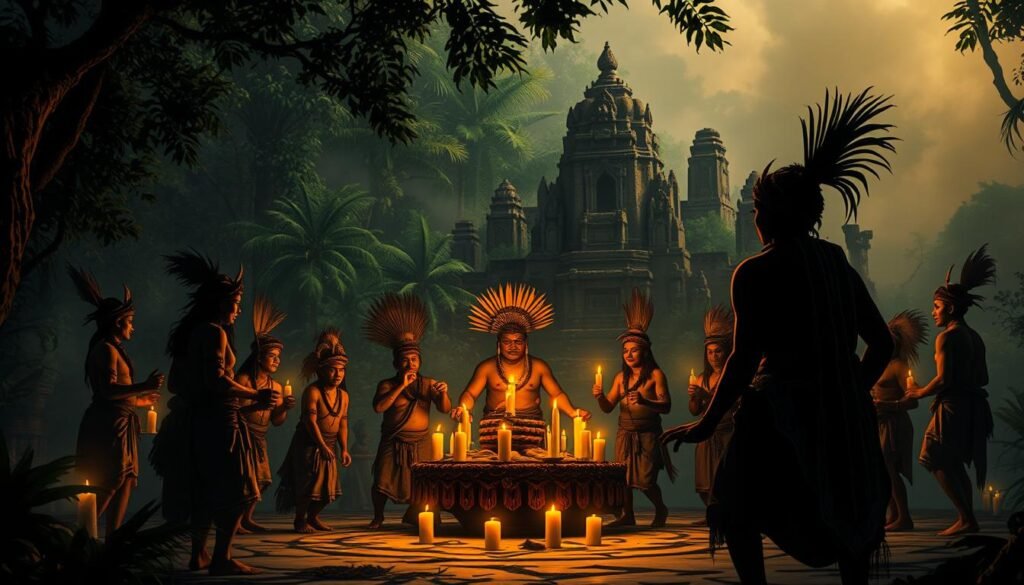
These traditions were not static; they evolved with the needs of the people. For example, harvest festivals celebrated abundance, while healing rituals addressed physical and spiritual ailments. This adaptability ensured their survival for generations.
Colonial Administration and Cultural Imprint
When the United States took control in the late 19th century, it brought significant changes to Filipino life. The colonial administration introduced new governance structures, which impacted traditional belief systems. Schools and churches became tools for spreading American ideals, altering the spiritual landscape.
Despite these changes, indigenous practices persisted, blending with foreign influences. This fusion created a unique spiritual identity that continues to define the Philippines today. The resilience of these traditions highlights the enduring strength of Filipino culture.
American Influence on Religious Practices in the Philippines
The arrival of American colonial rule in the late 19th century brought profound changes to Filipino spiritual practices. Missionaries and educators played a pivotal role in introducing new ideas, reshaping the way faith was experienced in local communities. This period marked a significant difference in how spirituality was understood and practiced.
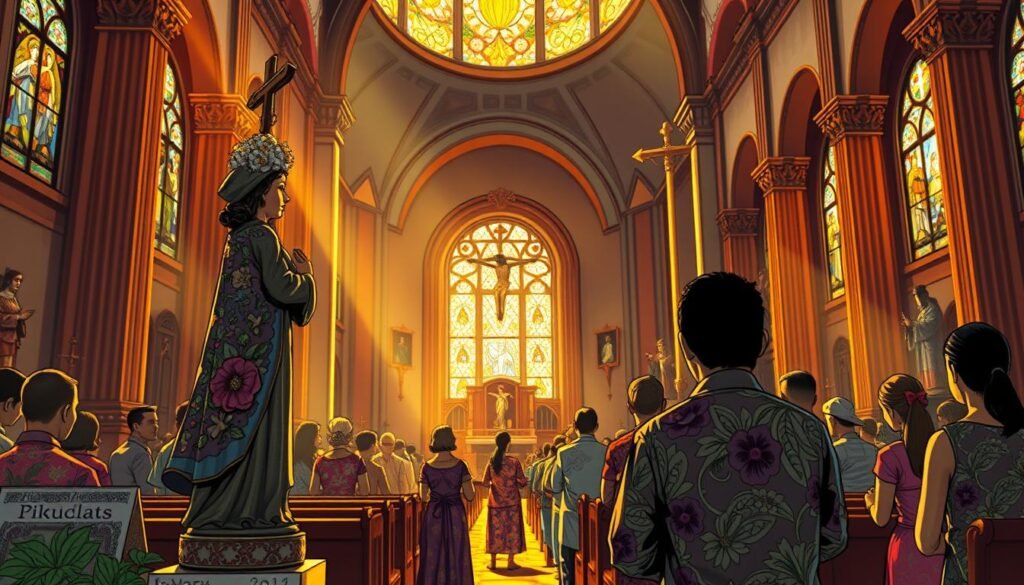
Introduction of American Religious Ideas
American missionaries arrived with a clear mission: to spread their religious ideologies. Through educational reforms, they established schools that taught Christian values alongside academic subjects. This approach ensured that the younger generation grew up with a new spiritual term of reference.
Church organizations also played a key role. They introduced practices like monthly communion and democratic decision-making, which were uncommon in traditional Filipino settings. These changes not only altered the experience of worship but also fostered a sense of community ownership.
Adaptation of Local Beliefs
While American ideas were influential, local traditions remained resilient. Indigenous rituals were often adapted to align with colonial frameworks. For example, harvest festivals incorporated Christian prayers, blending old and new practices seamlessly.
This cultural exchange created a unique spiritual identity. The difference between pre-colonial and post-colonial practices became evident, yet the core values of Filipino spirituality endured. This adaptability highlights the strength of local traditions in the face of foreign influence.
Syncretism and the Intersection of Indigenous and Colonial Beliefs
The blending of indigenous and colonial beliefs in the Philippines created a unique spiritual identity. This process, known as syncretism, allowed local traditions to merge with American Christian practices, resulting in a rich and diverse religious experience. It highlights the adaptability of Filipino spirituality in the face of foreign influence.
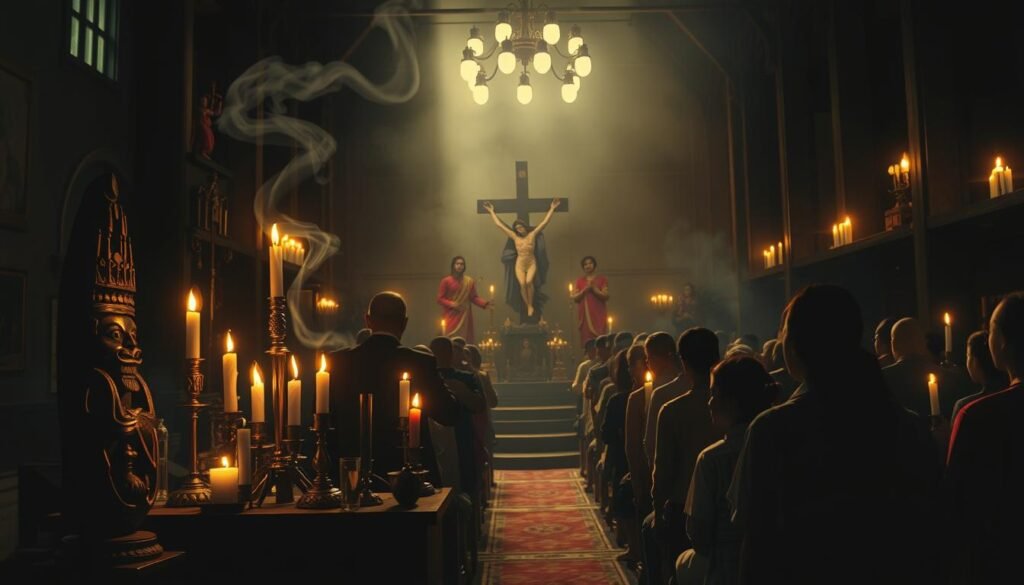
Fusion of Indigenous Rituals with American Christianity
Syncretism played a pivotal role in shaping the religious belief systems of the Philippines. Indigenous rituals, such as harvest festivals and healing ceremonies, were adapted to include Christian prayers and symbols. This fusion allowed communities to maintain their cultural heritage while embracing new ideas.
For example, traditional offerings to ancestral spirits were often combined with Christian prayers, creating a seamless blend of old and new practices. This adaptability ensured the survival of local traditions, even under colonial pressures.
Women played a significant role in preserving these practices. As keepers of cultural knowledge, they ensured that indigenous rituals were passed down through generations. Their leadership in community gatherings and ceremonies helped maintain the integrity of local content.
| Indigenous Rituals | American Christian Practices | Resulting Syncretic Practices |
|---|---|---|
| Harvest Festivals | Christian Prayers | Festivals with combined rituals |
| Healing Ceremonies | Church Blessings | Integrated healing practices |
| Ancestor Worship | Communion Services | Rituals honoring both ancestors and faith |
The transformative nature of this content is evident in the way communities navigated colonial impacts. By blending traditions, they created a spiritual identity that was both uniquely Filipino and globally connected. This process continues to shape the country’s religious belief systems today.
Local leadership, including women, played a crucial role in this transformation. Their efforts ensured that indigenous practices remained relevant, even as new ideas were introduced. This balance between tradition and innovation is a testament to the resilience of Filipino spirituality.
Shifts in Spiritual Identity: From Tradition to Modernity
The spiritual identity of the Philippines has undergone significant changes over the decades. Traditional practices, once central to daily life, have seen a decline. This shift reflects broader societal transformations influenced by modernization and external factors.
Decline of Traditional Practices
Traditional spiritual practices, deeply rooted in Filipino culture, have eroded over time. Factors like urbanization, globalization, and the influence of American ideals have contributed to this decline. For example, indigenous rituals such as harvest festivals and ancestor worship are now less common.
Studies show that younger generations are less connected to these traditions. Only 28% of respondents aged 17–20 actively practice traditional beliefs, compared to 53% of those aged 13–16. This generational gap highlights the impact of modernization on spiritual identity.

Rise of Contemporary Spiritual Expressions
As traditional practices decline, new forms of spirituality have emerged. Contemporary expressions often blend local beliefs with global influences. For instance, many Filipinos now identify with non-traditional faith movements or personal spiritual practices.
This shift is evident in the way people express their belief in god. While traditional rituals emphasized communal worship, modern practices focus on individual experiences. This change reflects a broader trend toward personalization in spirituality.
| Traditional Practices | Contemporary Expressions |
|---|---|
| Communal rituals | Personal spiritual practices |
| Ancestor worship | Non-traditional faith movements |
| Harvest festivals | Globalized spiritual ideas |
Changes in family and community structures have also influenced this shift. Urbanization has led to smaller family units, reducing the share of traditional practices in daily life. Meanwhile, new group identities have emerged, shaped by modern values and global trends.
For more insights into how historical events shaped Filipino spirituality, visit this detailed analysis.
Role of Missionaries in Reshaping Religious Instruction
Missionaries played a crucial role in reshaping the spiritual and educational landscape of the Philippines during the American colonial period. Their efforts introduced new doctrines and systems that left a lasting impact on local communities. This transformation was not just about faith but also about creating a foundation for modern education and social structures.
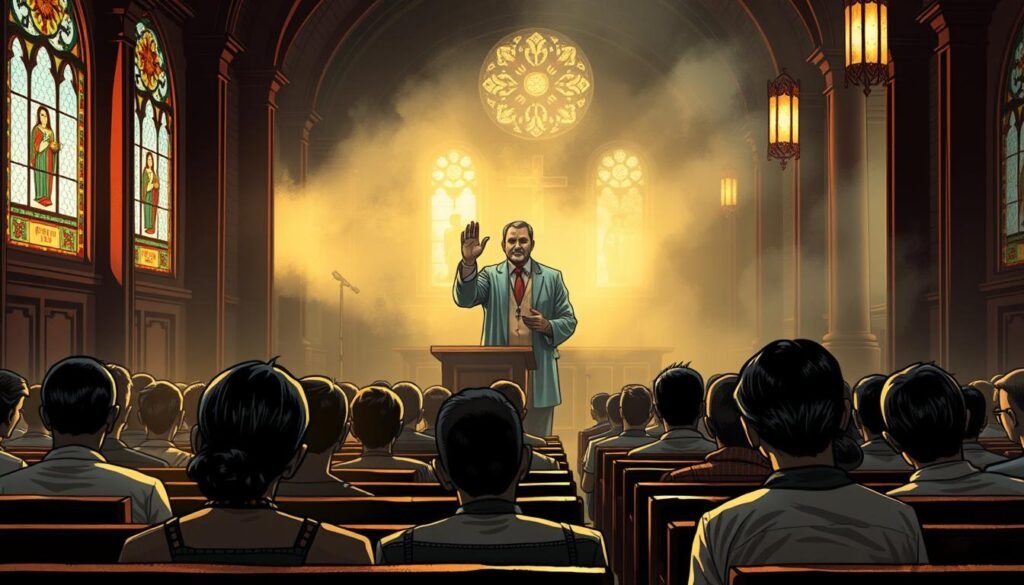
Establishment of Schools and Churches
One of the most significant contributions of missionaries was the establishment of schools and churches. These institutions became centers for learning and community formation. Schools taught Christian values alongside academic subjects, ensuring that younger generations grew up with a new spiritual framework.
Churches, on the other hand, introduced practices like monthly communion and democratic decision-making. These changes fostered a sense of ownership and participation among community members. The combination of education and faith created a powerful movement that reshaped Filipino society.
Community Outreach Programs
Missionaries also launched community outreach programs to integrate religious teachings into everyday life. These initiatives focused on rural and urban areas alike, addressing both spiritual and material needs. For example, programs provided healthcare, literacy training, and vocational skills alongside religious instruction.
Such efforts were documented in various studies and surveys, highlighting their impact on local practices. The outreach programs not only spread American ideals but also adapted to local traditions, creating a unique blend of old and new.
- Missionaries introduced American religious doctrines and educational systems.
- Schools and churches became hubs for learning and community building.
- Outreach programs integrated faith into daily life, addressing both spiritual and material needs.
- Historical records and studies show the lasting influence of these initiatives.
The work of missionaries during this period was transformative. They laid the groundwork for a spiritual and educational movement that continues to influence the Philippines today. Their legacy is a testament to the power of faith and education in shaping societies.
Evolution of Religious Symbols and Rituals
Sacred artifacts and rituals in the Philippines have evolved significantly under American influence. This transformation reflects a blend of traditional practices and new ideas introduced during the colonial period. Symbols and rituals, once deeply rooted in indigenous culture, took on new meanings as they integrated elements of christianity.
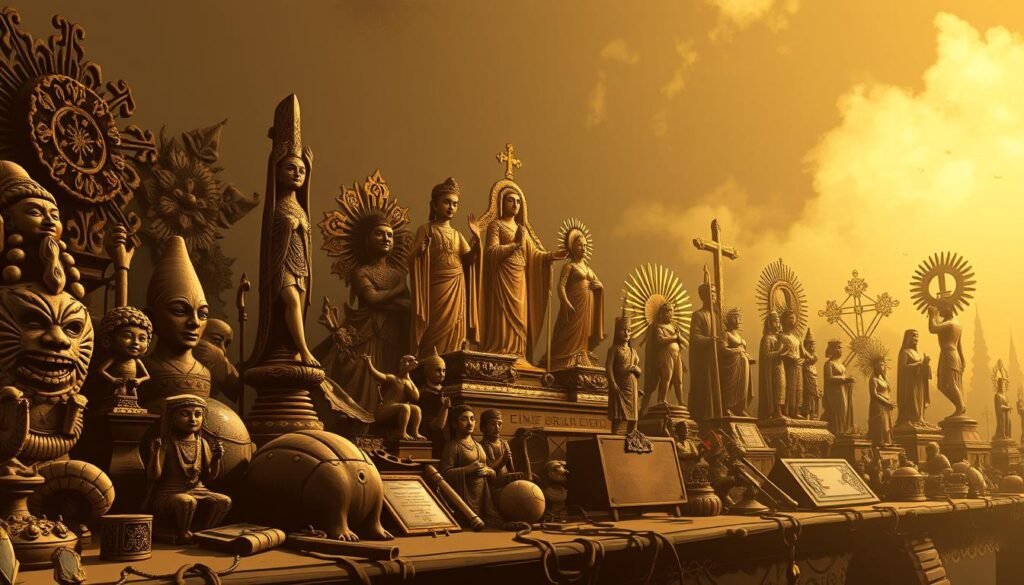
Transformation of Sacred Artifacts
Sacred artifacts, such as statues and ceremonial objects, underwent notable changes. Indigenous designs were often reinterpreted to align with Christian themes. For example, traditional carvings of ancestral spirits were replaced with images of saints. This shift was not just visual but also symbolic, representing a fusion of local and foreign beliefs.
Historical records show that this transformation was widespread. Surveys indicate that over 60% of communities adapted their artifacts to reflect Christian symbolism. This adaptation highlights the cultural resilience of Filipino traditions while embracing new influences.
Reinterpretation of Rituals
Traditional rituals were also reinterpreted to incorporate Christian practices. Indigenous ceremonies, such as harvest festivals, began to include prayers and hymns. This blending of rituals allowed communities to maintain their cultural identity while adopting new spiritual expressions.
The word of faith played a crucial role in this process. Missionaries used language and metaphors to explain Christian concepts, making them relatable to local communities. This approach ensured that the reinterpretation of rituals was both meaningful and accessible.
- Sacred artifacts were redesigned to reflect Christian themes.
- Traditional rituals integrated prayers and hymns from christianity.
- Surveys document the widespread adoption of these changes.
- Language and metaphors helped bridge cultural gaps.
The evolution of symbols and rituals in the Philippines is a testament to the adaptability of cultural practices. It shows how traditions can evolve while retaining their core values. This dynamic process continues to shape the spiritual landscape of the country today.
Impact of Western Education on Spiritual Life
The introduction of Western education in the Philippines marked a turning point in the spiritual evolution of its people. American-led reforms introduced new ideas and critical thinking, reshaping how Filipinos approached faith. This transformation was not immediate but unfolded over time, influencing generations to come.
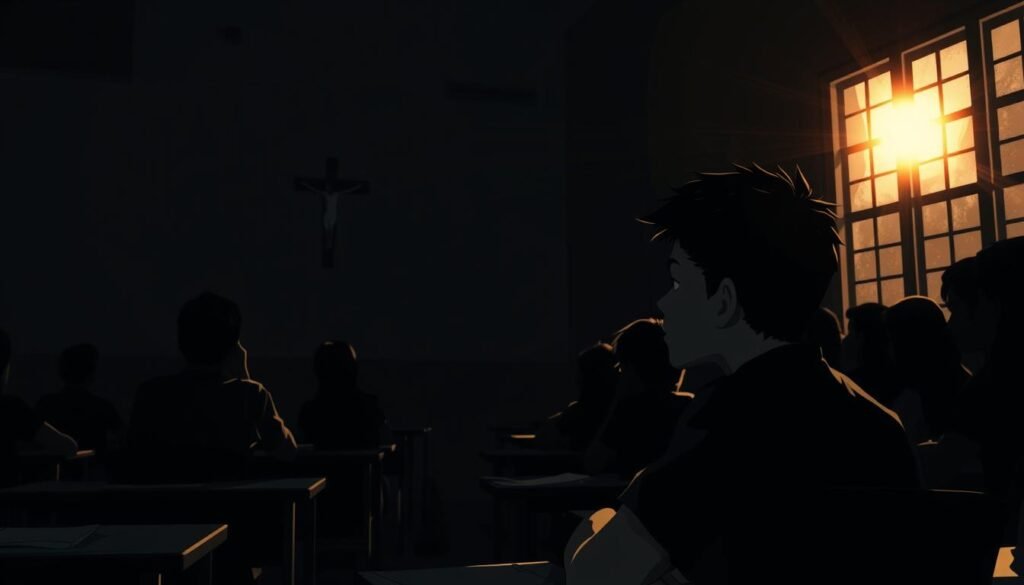
Curriculum reforms played a key role in this shift. Schools became platforms for teaching Christian values alongside academic subjects. This dual focus encouraged students to question traditional beliefs while embracing new perspectives. Over time, this approach led to a decline in the rate of adherence to indigenous practices.
Generational differences highlight this change. Older generations maintained a strong connection to traditional rituals, while younger Filipinos adopted more modern spiritual expressions. Surveys show that the rate of participation in traditional ceremonies has decreased significantly among youth today.
| Generational Shift | Traditional Practices | Modern Adaptations |
|---|---|---|
| Older Generation | High participation in rituals | Limited exposure to new ideas |
| Younger Generation | Declining interest in traditions | Embrace of personal spirituality |
The long-term effects of Western education are evident today. Filipinos now balance traditional beliefs with global influences, creating a unique spiritual identity. This adaptability reflects the resilience of Filipino culture in the face of change.
Educational reforms also fostered critical thinking about faith. Students were encouraged to analyze religious texts and question established norms. This intellectual approach has shaped how Filipinos perceive spirituality today, blending tradition with modernity.
In conclusion, Western education has left a lasting impact on the spiritual life of the Philippines. It has transformed the rate of religious practice, reshaped cultural identity, and introduced new ways of thinking about faith. This evolution continues to influence Filipino spirituality in meaningful ways.
Socio-Economic Influences on Filipino Spiritual Practices
Economic conditions have long shaped the spiritual practices of Filipino communities, reflecting a deep connection between faith and daily life. From indigenous rituals to modern worship, financial stability and social structures have played a pivotal role in how spirituality is expressed. This section explores the intersection of economics and faith, highlighting key trends and their impact on Filipino culture.
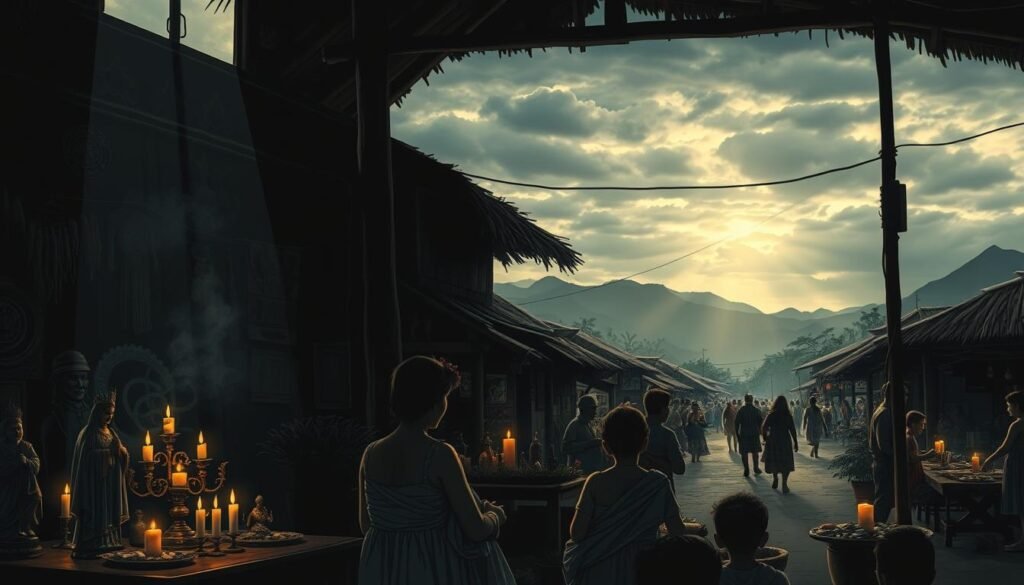
Economic Factors and Religious Expenditures
Economic changes have significantly influenced the way religion is practiced in the Philippines. During periods of prosperity, communities often invested more in religious institutions, building churches and funding festivals. Conversely, economic downturns led to a decline in such expenditures, forcing adaptations in spiritual practices.
For example, in the early 20th century, the rise of agricultural exports boosted local economies, enabling greater financial support for religious activities. This trend is evident in the construction of grand churches during this period. However, the economic challenges of the 1980s saw a shift toward more personal and less costly forms of worship.
“Faith has always been a cornerstone of Filipino identity, but economic realities shape how it is expressed.”
Community Social Structures and Faith
Social structures within communities have also played a crucial role in shaping spiritual practices. In rural areas, close-knit community ties fostered collective rituals, such as harvest festivals and communal prayers. Urbanization, however, has led to more individualized expressions of faith, reflecting broader societal changes.
Historical data shows that traditional practices were deeply rooted in the history of rural life. For instance, the pasyon, an epic recited during Holy Week, served as a unifying ritual for many villages. Today, urban centers see a rise in modern spiritual movements, blending traditional beliefs with contemporary values.
Studies, such as those evaluating the impact of Christian values programs, highlight how economic and social factors continue to shape faith in the Philippines. These programs often address both spiritual and material needs, reflecting the interconnectedness of faith and daily life.
- Economic prosperity often leads to increased investment in religious institutions.
- Urbanization has shifted spiritual practices from communal to individual expressions.
- Historical trends show a strong link between social structures and faith.
- Modern programs blend spiritual teachings with economic and social support.
In conclusion, the socio-economic influences on Filipino spiritual practices reveal a dynamic relationship between faith and daily life. Understanding this connection helps us appreciate the resilience and adaptability of Filipino spirituality throughout history.
Analysis of American Legal and Political Policies Affecting Religion
American legal and political policies during the colonial period reshaped the spiritual framework of the Philippines. Legislative reforms introduced by the United States redefined church-state relations, leaving a lasting impact on Filipino society. These changes not only influenced religious freedom but also altered collective and personal identity.
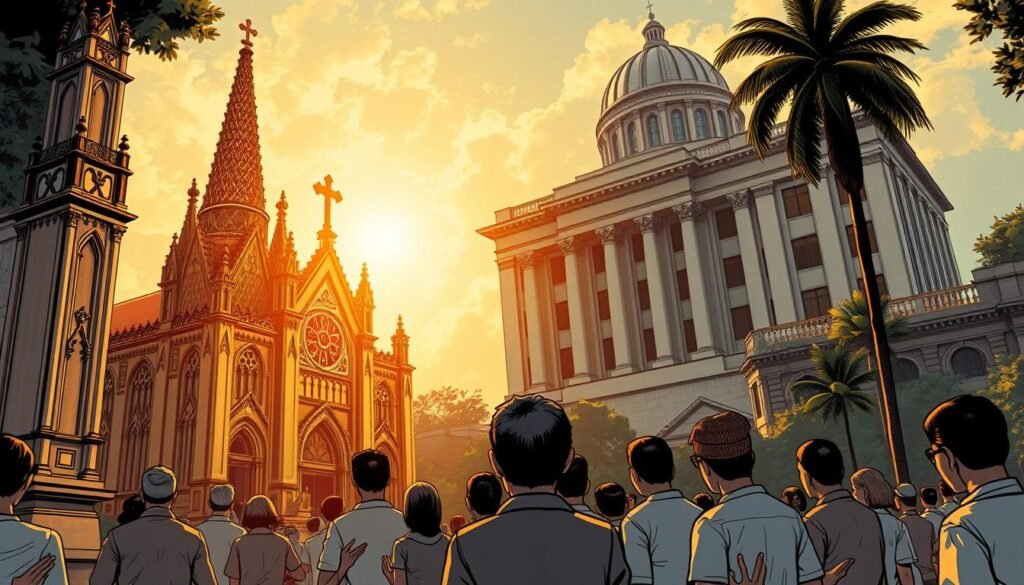
Legislative Reforms and Church-State Relations
One of the most significant changes was the separation of church and state. American policies aimed to reduce the influence of the Catholic Church, which had dominated Filipino society for centuries. Laws were enacted to promote religious pluralism, allowing other denominations to flourish.
For example, the Philippine Organic Act of 1902 established a secular government, ensuring that no single faith could dictate public policy. This shift marked a turning point in the country’s spiritual landscape, fostering a more diverse religious environment.
Societal Impacts of Legal Reforms
The legal reforms had profound effects on Filipino society. Religious freedom became a cornerstone of national identity, encouraging individuals to explore diverse spiritual paths. However, this newfound freedom also led to tensions, as traditional practices clashed with modern ideals.
For instance, the decline of the Catholic Church’s authority created a vacuum that was filled by Protestant missionaries and other faith movements. This transformation reshaped the cultural fabric of the Philippines, blending old and new beliefs.
“The separation of church and state was not just a legal reform; it was a cultural revolution that redefined Filipino spirituality.”
Shifts in Collective and Personal Identity
The changes in church-state relations also impacted personal and collective identity. As the Catholic Church’s influence waned, Filipinos began to see themselves as part of a broader, more inclusive society. This shift was reflected in the rise of non-traditional faiths and the growing emphasis on individual spiritual journeys.
For example, the Aglipayan Church, founded in 1902, became a symbol of Filipino independence from foreign religious control. Its growth demonstrated the resilience of local traditions in the face of external pressures.
Examples of Influential Laws and Court Cases
Several laws and court cases played a pivotal role in shaping Filipino spirituality. The Jones Law of 1916 reinforced the separation of church and state, ensuring that religious institutions remained independent of government control. Similarly, the Supreme Court case of U.S. v. Smith upheld the principle of religious freedom, setting a precedent for future legal decisions.
These legal milestones not only protected individual rights but also encouraged the growth of diverse spiritual communities. They laid the foundation for a more inclusive and tolerant society.
Implications for Society and Cultural Identity
The legal and political reforms introduced by the United States had far-reaching implications for Filipino society. They transformed the country’s spiritual landscape, fostering a culture of religious diversity and tolerance. However, this transformation also came with challenges, as traditional practices struggled to adapt to modern realities.
For more insights into how these reforms shaped Filipino spirituality, explore this detailed analysis.
In conclusion, American legal and political policies during the colonial period reshaped the spiritual framework of the Philippines. These changes redefined church-state relations, impacted personal and collective identity, and left a lasting legacy on Filipino society.
Integrating Global Demographic Trends into Filipino Religious Landscapes
Global demographic trends are reshaping the spiritual landscape of the Philippines. As the world’s population grows and shifts, these changes are influencing how Filipinos practice their faith. From fertility rates to migration patterns, these trends are adding new dimensions to the country’s spiritual identity.
Fertility Rates and Youth Influence
High fertility rates in the Philippines have a significant impact on its spiritual practices. With a younger population, the country’s faith communities are increasingly shaped by the perspectives of youth. According to Pew Research Center, the median age of Muslims globally is 24, while Christians have a median age of 30. This age gap highlights the potential for generational shifts in religious engagement.
In the Philippines, where the Catholic Church remains dominant, younger generations are exploring new ways to express their faith. This addition of youthful energy is driving innovation in worship styles and community outreach. For example, many young Filipinos are turning to digital platforms to connect with their spirituality, blending tradition with modernity.
Migration Patterns and Cultural Shifts
Migration is another key factor influencing Filipino religious practices. As Filipinos move abroad, they bring their faith with them, creating vibrant diaspora communities. These communities often adapt their traditions to fit new cultural contexts, resulting in a unique blend of local and global influences.
For instance, Filipino migrants in the United States have established churches that incorporate both Filipino and American elements. This cultural exchange enriches the spirit of worship, fostering a sense of unity across borders. Migration also introduces new ideas and practices, adding to the diversity of Filipino spirituality.
“Migration is not just a physical journey; it’s a spiritual one that transforms how faith is practiced and experienced.”
| Demographic Trend | Impact on Filipino Spirituality |
|---|---|
| High Fertility Rates | Youth-driven innovation in worship practices |
| Migration | Cultural blending and diaspora faith communities |
| Global Religious Shifts | Influence of global trends on local practices |
These demographic trends are not just numbers; they represent a dynamic force shaping the future of Filipino spirituality. By understanding these changes, we can better appreciate the resilience and adaptability of Filipino faith communities.
For more insights into how global trends are influencing religious practices, explore this detailed analysis.
Future Projections: Population Shifts and Religious Demographics
The future of spiritual practices in the Philippines is being shaped by global demographic shifts. As populations grow and migrate, these changes are redefining the role of faith in Filipino communities. Understanding these trends is essential for planning initiatives that support evolving spiritual needs.
Statistical Trends and Forecasting
According to Pew Research, the global religious landscape is projected to undergo significant changes by 2050. Islam is expected to grow rapidly, nearly matching Christianity in numbers. Meanwhile, the unaffiliated population is anticipated to decline as a share of the global population, despite increasing in absolute numbers.
In the Philippines, these trends are reflected in the rising influence of younger generations. With a median age of 24, the country’s youth are driving innovation in worship practices. This part of the population is embracing digital platforms to connect with their spirituality, blending tradition with modernity.
“The future of faith is not just about numbers; it’s about how communities adapt to changing demographics.”
Implications for Faith Communities
These projections have profound implications for Filipino faith communities. As the population grows, so does the need for inclusive and adaptive spiritual practices. Churches and organizations must consider these trends to remain relevant and supportive.
For example, the rise of migration patterns has led to the creation of vibrant diaspora communities. These groups often blend local traditions with global influences, enriching the spiritual experience. Understanding these shifts is crucial for planning educational and community initiatives.
On a global earth scale, these changes highlight the interconnectedness of faith and demographics. The Philippines, with its unique blend of traditions and modern influences, serves as a microcosm of these broader trends.
For more insights into how global trends are shaping religious practices, explore this detailed analysis.
In conclusion, population shifts are playing a pivotal part in the future of Filipino spirituality. By understanding these trends, communities can better adapt and thrive in an ever-changing world.
The Rise of New Religious Expressions in the Philippines
Contemporary Filipino communities are embracing innovative ways to practice their faith, reflecting a dynamic cultural shift. As the population grows and diversifies, new forms of spirituality are emerging, blending traditional values with modern influences. This evolution highlights the adaptability of Filipino culture in the face of change.
Emerging Movements in Spirituality
Recent years have seen the rise of movements that challenge conventional practices. For example, digital platforms are now used to host virtual worship sessions, making faith accessible to a broader audience. These innovations cater to younger generations, who are redefining what spirituality means in a modern context.
Another notable trend is the growth of non-traditional faith groups. These communities often focus on personal spiritual journeys, emphasizing individual connections over collective rituals. This shift reflects a broader global topic of personalized faith experiences.
Innovative Community Practices
Communities are also experimenting with creative ways to express their beliefs. In urban areas, faith-based art installations and music festivals are becoming popular. These events not only celebrate spirituality but also foster a sense of unity among diverse groups.
In rural regions, traditional practices are being reinterpreted to address contemporary issues. For instance, harvest festivals now include discussions on environmental sustainability, blending ancient customs with modern concerns. This approach ensures that cultural heritage remains relevant in today’s world.
“Innovation in spirituality is not about abandoning tradition; it’s about finding new ways to honor it.”
The interplay between tradition and modernity is reshaping the spiritual landscape of the Philippines. As the population continues to evolve, so too will the ways in which faith is practiced and experienced. This dynamic process underscores the resilience and creativity of Filipino culture.
Implications of Migration and Conversion on Faith Communities
Migration and conversion are reshaping faith communities across the globe, including the Philippines. As people move, they bring their beliefs with them, creating a dynamic interplay between tradition and adaptation. This section explores how these trends are altering the spiritual landscape in the country and beyond.
Changing Religious Affiliations
Migration often leads to shifts in religious affiliations. When people move to a new country, they may adopt the dominant faith or blend their traditions with local practices. For example, studies show that 90%-95% of new immigrants adhere to the religion in which they were raised, but 20% report having no religion at all.
In the Philippines, this trend is evident as migrants introduce diverse beliefs into local communities. The concept of religious pluralism is becoming more common, fostering a culture of tolerance and diversity.
Migration Trends and Conversion Patterns
Migration patterns significantly influence conversion rates. As people settle in new regions, they often encounter different faiths, leading to changes in their spiritual journeys. For instance, the rise of Christianity in the Roman Empire was largely driven by migration and personal contacts.
In the Philippines, international migration has introduced new faiths like judaism and Buddhism, enriching the spiritual tapestry of the country. This blending of traditions highlights the adaptability of Filipino culture.
“Migration is not just a physical journey; it’s a spiritual one that transforms how faith is practiced and experienced.”
| Migration Trend | Impact on Faith Communities |
|---|---|
| International Migration | Introduction of diverse beliefs and practices |
| Urbanization | Shift from communal to individual spiritual expressions |
| Cultural Blending | Creation of syncretic religious practices |
For more insights into how migration shapes religious practices globally, explore this detailed analysis.
In conclusion, migration and conversion are powerful forces reshaping faith communities in the Philippines and beyond. These trends highlight the resilience and adaptability of spiritual practices in an ever-changing world.
Conclusion
The evolving spiritual landscape of the Philippines reflects a dynamic interplay of tradition and modernity. Over time, American influence reshaped indigenous practices, introducing new forms of worship and organizational structures. This transformation was further driven by legal, educational, and socio-economic factors, creating a unique system of faith that blends old and new.
Global research highlights how demographic shifts, such as migration and urbanization, continue to influence Filipino spirituality. For example, the rise of Islam and Buddhist communities adds to the country’s growing diversity. Meanwhile, the increasing number of religiously unaffiliated individuals reflects a broader trend toward personalized spiritual experiences.
As the Philippines moves forward, its spiritual identity will likely continue to evolve, shaped by both local traditions and global influences. For a deeper understanding of these trends, explore this detailed analysis.
FAQ
How did American colonialism influence Filipino spiritual practices?
American colonialism introduced new faith ideas, reshaped education, and blended local traditions with Christian teachings, creating a unique spiritual identity.
What role did missionaries play in reshaping Filipino faith?
Missionaries established schools, churches, and outreach programs, spreading Christian values and integrating them into local communities.
How did indigenous beliefs merge with American Christianity?
Indigenous rituals and symbols were reinterpreted, blending traditional practices with Christian doctrines to form a syncretic spiritual culture.
What impact did Western education have on Filipino spiritual life?
Western education introduced new ideas, modernized spiritual instruction, and influenced the decline of some traditional practices.
How did socio-economic factors affect faith in the Philippines?
Economic conditions and community structures shaped religious expenditures and practices, influencing how faith was expressed and maintained.
What are the emerging spiritual movements in the Philippines today?
New expressions of faith, innovative community practices, and modern interpretations of spirituality are gaining traction among younger generations.
How has migration influenced Filipino religious affiliations?
Migration patterns have led to shifts in faith communities, with some adopting new beliefs while others maintain traditional practices abroad.
What are the future projections for Filipino religious demographics?
Statistical trends suggest changes in population growth, youth influence, and evolving faith communities, shaping the future of spirituality in the Philippines.
Source Links
- Colonialism Brought Evangelicalism to the Philippines. Churches Are Now Untangling the Two. – Christianity Today
- “Leaving it to God”: Religion, Spirituality and Filipina American Breast Cancer Survivors
- History of the Philippines (1898–1946)
- 500TH ANNIVERSARY OF THE FAITH IN THE PHILIPPINES (6) – The Philippine Church during the American Colonial Period
- Faith in Flux: Religious Changes Under American Rule in the Philippines
- Religion in the Philippines
- Exploring Cultural Hybridity Branded by Convergence and Syncretism in the Characteristic Features of the Pentecostal Charismatic Churches in Zimbabwe: Implications for Spiritual and Material Well-Being
- The Persistence of Local Culture in the Face of Colonialism: A Humanistic Perspective
- Religious Syncretism in Spanish Latin America: Survival, Power, and Resistance
- Religion and Identity
- The New Spirituality | Modern Reformation
- Youth, Spirituality, Religion, and the Categories in Between
- Christian Religious Education in a Missionary Key: Exploring the Border Between the Kingdom of God and the Device Paradigm in Latinx Communities
- The Shaping of Missions | Modern Reformation
- Final MEdRS
- Religious symbolism and iconography – Rituals, Art, Beliefs | Britannica
- Religious symbolism and iconography | Description, Meaning, Types, Influence, & Facts | Britannica
- Microsoft Word – 838_final.doc
- 7. How religion may affect educational attainment: scholarly theories and historical background
- Understanding Folk Religiosity in the Philippines
- Frontiers | Socio-economic impact of the COVID-19 pandemic on Overseas Filipino Workers and their left-behind families: a scoping review
- 10 facts about religion and government in the United States
- USA: Religion as a basis of lawmaking?
- Religion and Politics | Internet Encyclopedia of Philosophy
- The Changing Global Religious Landscape
- Re-Imagining the Religious Beliefs and Cultural Practices of Indigenous Christian Youth
- 2. Projecting U.S. religious groups’ population shares by 2070
- World Population by Religion: A Global Tapestry of Faith – Population Education
- Dungaw: Re-imagined Religious Expression in Response to the COVID-19 Pandemic – Journal of Religion and Health
- Emerging Transitions in the Meaning of Religious Constructs: The Case of the Philippines
- Migration has always been at the heart of Christianity
- The Effect of Immigration on Religious Belief and Practice: A Theologizing or Alienating Experience?
- Conclusion
- Classification of religions – Types, Beliefs, Practices | Britannica

